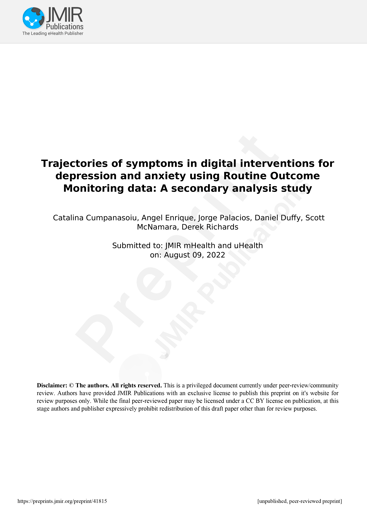
Trajectories of symptoms in digital interventions for depression and anxiety using Routine Outcome Monitoring data: A secondary analysis study

Authors
Catalina Cumpanasoiu, Angel Enrique, Jorge Palacios, Daniel Duffy, Scott McNamara, Derek Richards
Submitted to: JMIR mHealth and uHealth on: August 09, 2022
Abstract
Background: Research suggests there is heterogeneity on treatment response for internet-delivered CBT (iCBT) users, but few studies have investigated the trajectory of individual symptom change across iCBT treatment. Large patient datasets using routine outcome measures provides an opportunity to investigate treatments effect over time, as well as the relationship between
outcomes and platform usage. Understanding these different trajectories of symptom change, as well as associated
characteristics, may prove important for tailoring interventions or identifying patients who may not benefit from the intervention.
Objective: The aim was to identify latent trajectories of symptom change during the iCBT treatment course for depression and anxiety and to investigate the patients’ characteristics and platform usage for each of these classes.
Methods: This is a secondary analysis of data from a Randomized Controlled Trial designed to examine the effectiveness of guided-iCBT for anxiety and depression in the UK’s Improving Access to Psychological Therapies (IAPT) program. The present work includes patients from the intervention group?(N=256) and?follows?a longitudinal,?retrospective?design. As part of IAPT’s Routine Outcome Monitoring system, patients?were prompted to complete PHQ-9 and GAD-7 after each supporter review during treatment period.?Latent class growth analysis was used to identify underlying trajectories of symptom change across the treatment period for both, depression and anxiety. Differences in patient characteristics were then evaluated between these trajectory classes, and the presence of a time-varying relationship between platform usage and trajectory classes was investigated.
Results: Five-class models were identified as the optimal ones for both depression and anxiety as measured using the PHQ-9 and GAD-7 respectively. Two thirds (70%) of the sample formed various trajectories of improvement classes that differed on baseline score, pace of symptom change, and final clinical outcome score. The remaining patients were in two smaller groups, one that saw minimal to no gains and another with consistently high scores across the treatment journey. No significant associations were found between different types of trajectories and baseline patient characteristics (age, sex, employment status, presence of long-term condition). While we did not find a time-varying relationship between usage and trajectory classes, we found an overall effect of time on platform usage suggesting that all participants used the intervention significantly more in the first four weeks.
Conclusions: Most patients benefit from treatment and the various patterns of improvement have implications for how the iCBT intervention is delivered. Identifying predictors of non-response or early response might inform the level of support and monitoring required for different types of patients. Further work is necessary to explore differences between these trajectories to understand what works best for whom and to identify early-on those patients who are less likely to benefit from treatment.
(JMIR Preprints 09/08/2022:41815) DOI: https://doi.org/10.2196/preprints.41815






